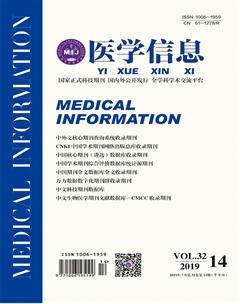根尖微渗漏影响因素的研究
2019-08-26贾冬萍王秀梅刘亭亭
贾冬萍 王秀梅 刘亭亭
摘要:根管治疗术是牙髓病和根尖周病首选的、最有效的治疗方法,根管的消毒、扩大成形以及根尖区的严密封闭是其重要的操作步骤,彻底清除根管内感染源并防止根管再感染是其基础和目标。根尖微渗漏是根管治疗术后根管因再感染而出现根尖周炎症的危险因素,是根管治疗失败的主要原因。根尖微渗漏的产生是多个因素协同作用的结果,研究根管治疗过程中根尖微渗漏的影响因素,为降低和防止根尖微渗漏的发生提供指导,对提高根管治疗成功率具有重要作用。本文就根管治疗过程中根尖微渗漏影响因素的研究进展作一综述。
关键词:根尖微渗漏;根管预备;根管充填
中图分类号:R781.05 文献标识码:A DOI:10.3969/j.issn.1006-1959.2019.14.012
文章编号:1006-1959(2019)14-0032-04
Abstract:Root canal therapy is the most effective and effective treatment for endodontic diseases and periapical diseases. The disinfection, enlargement of the root canal and strict sealing of the apical area are important steps to completely remove the root canal. Infecting the source and preventing reinfection of the root canal is its foundation and goal. The apical microleakage is a risk factor for periapical inflammation in the root canal due to reinfection after root canal treatment, and is the main cause of failure of root canal treatment. The occurrence of apical microleakage is the result of synergistic effects of multiple factors. Studying the influencing factors of apical microleakage during root canal treatment provides guidance for reducing and preventing the occurrence of apical microleakage, and improving the success of root canal treatment. The rate plays an important role. This article reviews the research progress of factors affecting root tip microleakage during root canal treatment.
Key words:Apical microleakage;Root canal preparation;Root canal filling
根管治療术是牙髓病和根尖周病最完善、最有效的治疗方法,它强调根管系统的预备、消毒和严密的三维根管充填。临床根管治疗成功率约为70%~90%,63%的根管治疗失败与根尖微渗漏有关[1]。由于根尖封闭不良,细菌、口腔微生物及其代谢产物等刺激因素可再次进入根管导致一系列不良后果。根尖微渗漏的产生与根尖微渗漏与根管预备器械、根管充填糊剂、根管充填技术等多个因素有关[2]。本文就根管治疗过程中根尖微渗漏影响因素的研究进展作一综述。
1根管预备对根尖微渗漏的影响
1.1根管偏移 临床上进行根管预备时会不可避免的发生根管偏移,尤其是对细小弯曲根管的预备更容易出现根管偏移,影响根管治疗的远期疗效[3]。发生偏移的根管,根尖部的凸壁容易残留细菌和感染的牙髓,且根尖狭窄会向冠方移位,降低根尖区封闭的严密程度,加大根尖微渗漏[4]。镍钛器械是现代根管预备的主流器械,每个镍钛系统的弹性性能和运动模式不同,根管预备过程中对根管壁产生的影响也会存在差异。根管预备器械的钢性及锥度越大,根管偏移的发生率也越大,旋转预备比提拉式预备产生根尖偏移的风险更大[5]。Pro Taper Next连续旋转式运动镍钛器械对根管的中心定位能力好,根管偏移量小于Reciproc往复式运动镍钛器械,根尖微渗漏的发生率也低于Reciproc[6]。
1.2牙本质裂纹 机用镍钛器械预备根管时,其成形能力好,切割效率高,但预备根管过程中应力集中在根管内壁,不可避免的会导致牙本质产生细小的裂纹[7]。细菌、微生物及其代谢产物聚集在牙本质裂纹处,导致根尖微渗漏的发生[8]。刚性越强、锥度越大的根管预备器械,预备过程中对根管壁产生的应力越大,根管壁的牙本质产生裂纹的概率也越大[9]。不同根管预备器械会对根尖孔表面产生不同程度的细小裂纹,随着时间的推移形成根尖微渗漏,影响根管治疗的成功率。Pro Taper Next、Wave One Gold、M3三种机用镍钛器械材质柔韧性强、旋入效应低,相比Pro Taper Universal可明显减少牙本质裂纹发生[10]。X+File与 Pro Taper Next 产生的完全裂纹和不完全裂纹较Pro Taper Universal少,这与镍钛器械的尖端横截面形态、运动模式以及中心定位能力有关[11]。牙本质裂纹在复杂咬合应力作用下可能会造成牙根的纵裂,最终导致根管治疗术失败[12]。
1.3器械分离 根管弯曲度大、牙髓钙化、操作不当等原因都可导致根管预备过程中器械分离的发生。机用镍钛锉是临床上广泛应用的根管预备器械,Wang NN等[13]指出镍钛器械预备根管过程中发生器械分离的概率为0.7%~7.4%,高于传统不锈钢器械。折断于根管内的器械内不仅会阻碍感染物质及细菌的清除,器械的沟槽也会聚集玷污层,加大了根尖微渗漏[14]。分离器械的断端越靠近根尖区取出越困难。位于根尖区较短的折断器械,一般都无法到达工作长度,取出困难又容易被推出根尖孔,不利于后续操作的进行,影响根管治疗的远期疗效及预后[15]。
1.4玷污层 根管预备过程中会产生牙本质碎屑,这些牙本质碎屑混合根管内的细菌、坏死组织等形成玷污层黏在根管内壁上,可深达牙本质小管40 μm[16]。玷污层不仅会阻碍根尖封闭剂的抗菌成分向牙本质小管的渗入,也会妨碍根管充填材料与根管内壁的紧密贴合,使根尖微渗漏增加[17]。因此,根管治疗过程中对玷污层的清理能有效降低根微渗漏的发生率。去除玷污层的方法有化学法、超声法、激光法,根管内壁有玷污层的根尖微渗漏深度远大于根管内壁去除掉玷污层的根尖微渗漏深度。有研究发现[18],玷污层的去除能使更多的牙本质小管开放,从而增加了根管充填材料与根管内壁的适应性,减少根尖微渗漏。
2根管冲洗对根尖微渗漏的影响
理想的根管冲洗剂应该具有抗菌、润滑、去除玷污层以及生物安全性等特点。临床常用的冲洗剂包括次氯酸钠(NaClO)、氯己定(CHX)、乙二胺四乙酸(EDTA)等。CHX能使细胞壁的通透性提高,从而获得稳定且持久的抗菌效果,其生物安全性也较好,冲洗根管后对健康的牙本质没有影响,不会加大根尖微渗漏现象[19]。NaClO具有较强的抑菌活性,且能溶解玷污层中的有机成分,常用的浓度为1.00%~5.25%,浓度过高会影响牙本质的理化性能,但是,NaClO不能用作终末冲洗溶液,因为NaClO不利于树脂的聚合,会降低牙本质的粘接强度,从而会增大根尖微渗漏[20]。EDTA是一种金属螯合剂,能够有效去除玷污层的无机成分,增加牙本质小管的开放数量,从而增强了封闭剂和牙本质之间的嵌合,减小根尖微渗漏的发生[21]。组合成分(QMix)是一种新型根管冲洗溶液,其表面活性成分不仅能够减低冲洗溶液的表面张力,还能增加根管壁的湿润性,增强牙本质的粘结强度,减小根尖微渗漏[22]。先用NaClO再用17%EDTA交替冲洗根管,然后用生理盐水清除NaClO,最后以QMix终末冲洗根管,能够最大程度的清除根管内的细菌、微生物、内毒素以及玷污层等,显著提高根管冲洗的有效量,增强牙本质的粘结强度,降低根尖微渗漏的发生率[23]。根管冲洗溶液配合机械振动、超声荡洗或者激光,可以增大与根管内壁的接触面积,更好的清除根管内感染物质和牙本质碎屑。
3根管充填对根尖微渗漏的影响
3.1根尖封闭剂 根尖封闭剂要求具有抗菌、充填及润滑等作用,常用的根管封闭剂有:氧化锌丁香油封闭剂(ZOE)、氢氧化钙类封闭剂(Vitapex)树脂类封闭剂(AH Plus)及生物陶瓷类封闭剂(iRoot SP)等。ZOE抑菌镇痛效果好,但流动性较差,根管侧枝及弯曲根管难以进入,且遇唾液和水容易收缩,根尖微渗漏发生率高[24]。Vitapex具有杀菌、灭活内毒素、促进根尖硬组织的形成等作用,有可吸收性;iRoot SP可用于感染严重的根管,其对根管壁的机械嵌合力和化学粘接力强,根尖封闭效果优越,超出根尖孔术后反应也较小;AH Plus流动性好,溶解性低,与牙本质粘接性较好,但对根尖周组织刺激性稍大[25]。Yanpiset K等[26]实验发现iRoot SP的根尖封闭性能优于AH Plus,根尖微渗漏低,两者差异无统计学意义。Nair AV[27]等指出,iRoot SP能诱导骨组织再生,可生物封闭根尖孔,根管治疗成功率高率。Shashirekha G等[28]发现AH Plus的根尖封闭效果较Vitpex好,根管充填完成后根尖微渗漏发生率小。
3.2根管充填方法 研究发现,充填不严密的根管出现根尖微渗漏的概率为45%,而充填致密的根管僅有7%会出现根尖微渗漏[29]。目前根管充填的方法包括冷侧压根管充填法、热牙胶根管充填法和Gutta Flow常温流动牙胶充填法,热牙胶根管充填法又分为热牙胶垂直加压充填法和固体核心载体充填法。不同的根管充填方法会影响根尖封闭效果:热牙胶垂直加压充填技术形成的根尖微渗漏显著小于冷牙胶侧压法;固体核心载体充填产生根尖微渗漏的概率小于热牙胶垂直加压充填技术;常温流动牙胶充填法的根尖微渗漏低于热牙胶垂直加压充填技术[30,31]。
4根管形态对根尖微渗漏的影响
根管形态复杂,包括根管侧支、根尖分歧、根尖分叉、根管峡部和严重弯曲根管等,根管治疗器械很难到达这些地方。因此,即使主根管,也很少和根管预备器械形态一致。无论使用何种根管预备器械和根管预备方法,都会不可避免的残留未预备的根管壁,细菌、微生物、牙本质碎屑等聚集在此未预备区域,严重影响了根管的封闭性,加大了根尖微渗漏的发生率[32]。根管数目的复杂性也常出现致因遗漏根管而导致根管治疗失败的现象。现有根管治疗的材料和器械都是针对圆形根管横截面设计的,因此,扁圆形根管内壁在预备时管常会遗留较多的未切削部分,易发生根尖微渗漏[33]。根管直径和锥度较大(相比根管锉)的根管根管充填完后发生根尖微渗漏的概率较高[34]。
5总结
根管预备、冲洗、充填各个步骤以及根管形态等都可能影响根尖微渗漏的发生,而根尖微漏则直接影响根管治疗的远期效果和成功率。因此,注重根管治疗的每个环节,减少和预防根尖微渗漏的发生,防止根管再感染,是根管治疗的重要内容。
参考文献:
[1]Jafari F,Jafari S.Importance and methodologies of endodontic micro-leakage studies:A systematic review[J].J Clin Exp Dent,2017,9(6):812-819.
[2]?譈stün Y,Aslan T,Sekerci AE,et al.Evaluation of the Reliability of Cone-beam ComPuted TomograPhy Scanning and Electronic APex Locator Measurements in Working Length Determination of Teeth with Large PeriaPical Lesions[J].J Endod,2016,42(9):1334-1337.
[3]Amaral CCF,Ormiga F,Boldrini LC,et al.Evaluation of the effects of the solution used for electrochemical dissolution of nickel-titanium endodontic files on dentine structure,microhardness and cell viability[J].Int Endod J,2018,51(12):1434-1445.
[4]Madani ZS,Goudarzipor D,Haddadi A,et al.A CBCT Assessment of apical transportation in root canals prepared with hand K-flexofile and K3 rotary instruments[J].Iran Endod J,2015,10(1):44-48.
[5]Nagendrababu V,Ahmed HMA.Shaping properties and outcomes of nickel-titanium rotary and reciprocation systems using micro-computed tomography:a systematic review[J].Quintessence Int,2019,50(3):186-195.
[6]Marceliano-Alves MF,Sousa-Neto MD,Fidel SR,et al.Shaping ability of single-file reciprocating and heat-treated multifile rotary systems:A micro-CT study[J].Int Endod J,2015,48(12):1129-1136.
[7]Ahn SY,Kim HC,Kim E.Effects of Nickel-Titanium Instruments with Reciprocating or Continuous Rotation Motion:A Systematic Review of In Vitro Studies[J].J Endod,2016,42(7):1009-1017.
[8]王全禹,薛明.鎳钛器械根管预备对牙本质微裂的影响及预防[J].中国实用口腔科杂志,2017,10(4):207-211.
[9]Nishad SV,Shivamurthy GB.Comparative Analysis of Apical Root Crack Propagation after Root Canal Preparation at Different Instrumentation Lengths Using ProTaper Universal,ProTaper Next and ProTaper Gold Rotary Files:An In vitro Study[J].Contemp Clin Dent,2018,9(Suppl 1):S34-S38.
[10]Kumari MR,Krishnaswamy MM.Comparative Analysis of Crack Propagation in Roots with Hand and Rotary Instrumentation of the Root Canal-An Ex-vivo Study[J].J Clin Diagn Res,2016,10(7):ZC16-ZC19.
[11]Qiu N,Wang CY,Liu YF,et al.Comparison of the shaping ability of three NiTi rotary instruments in the preparation of simulated curved root canals[J].Shanghai Journal of Stomatology,2016,25(2):191-194.
[12]Bayram HM,Bayram E,Ocak M,et al.Micro-computed Tomographic Evaluation of Dentinal Microcrack Formation after Using New Heat-treated Nickel-titanium Systems[J].J Endod,2017,43(10):1736-1739.
[13]Wang NN,Ge JY,Xie SJ,et al.Analysis of Mtwo rotary instruments and Reciprocating Instruments:A Mini-Review of Clinical Studies[J].Open Dent J,2018,25(12):864-872.
[14]Fernández-Pazos G,Martín-Biedma B,Varela-Pati?觡o P,et al.Fracture and deformation of ProTaper Next instruments after clinical use[J].J Clin Exp Dent,2018,10(11):e1091-e1095.
[15]Ertas H,Iysal B.Effect of separated rotary instruments on the apical micro-leakage of root canal fillings[J].J Dent Fac Atatürk Uni,2014,24(2):246-251.
[16]Singh S,Singh M,Salgar AR,et al.Time-Dependent Effect of Various Irrigants for Root Canal on Smear Layer Removal[J].J Pharm Bioallied Sci,2019,11(Suppl 1):S51-S58.
[17]Zargar N,Dianat O,Asnaashari M,et al.The Effect of Smear Layer on Antimicrobial Efficacy of Three Root Canal Irrigants[J].Iran Endod J,2015,10(3):179-183.
[18]Verma M,Meena N,Kumari RA,et al.Comparison of apical debris extrusion during root canal preparation using instrumentation techniques with two operating principles: An in vitro study[J].J Conserv Dent,2017,20(2):96-99.
[19]Mohammadi Z,Yaripour S,Shalavi S,et al.Root Canal Irrigants and Dentin Bonding:An Update[J].Iran Endod J, 2017,12(2):131-136.
[20]Lahorsoler E,Mirandarius J,Brunetllobet L,et al.In vitro study of the apical micro-leakage with resilon root canal filling using different final endodontic irrigants[J].J Clin Exp Dent,2015,7(2):e212-e217.
[21]Balasubramanian SK,Saraswathi V,Ballal NV,et al.A comparative study of the quality of apical seal in resilon/epiphany SE fol-lowing intra canal irrigation with 17% EDTA,10% citric Acid,and MTAD as Final Irrigants-A dye leakage study under vacuum[J].J Clin Diagn Res,2017,11(2):ZC20-ZC24.
[22]Arslan D,Guneser MB,Dincer AN,et al.Comparison of Smear Layer Removal Ability of QMix with Different Activation Techniques[J].J Endod,2016,42(8):1279-1285.
[23]Shin JH,Lee DY,Lee SH.Comparison of antimicrobial activity of traditional and new developed root sealers against pathogens related root canal[J].J Dent Sci,2018,13(1):54-59.
[24]Phukan AH,Mathur S,Sandhu M,et al.The effect of different root canal sealers on the fracture resistance of endodontically treated teeth-in vitro study[J].Dent Res J (Isfahan),2017,14(6):382-388.
[25]Al-Haddad AY,Kutty MG,Abu Kasim NH,et al.The effect of moisture conditions on the constitution of two bioceramic-based root canal sealers[J].J Dent Sci,2017,12(4):340-346.
[26]Yanpiset K,Banomyong D,Chotvorrarak K,et al.Bacteage and micro-computed tomography evaluation in round-shaped canals obturated with bioceramic cone and sealer using matched single cone technique[J].Restor Dent Endod,2018,43(3):e30-e34.
[27]Nair AV,Nayak M,Prasada LK,et al.Comparative Evaluation of Cytotoxicity and Genotoxicity of Two Bioceramic Sealers on Fibroblast Cell Line:An in vitro Study[J].J Contemp Dent Pract,2018,19(6):656-666.
[28]Shashirekha G,Jena A,Pattanaik S,et al.Assessment of pain and dissolution of apically extruded sealers and their effect on the periradicular tissues[J].J Conserv Dent,2018,21(5):546-550.
[29]Riis A,Taschieri S,Del Fabbro M,et al.Tooth Survival after Surgical or Nonsurgical Endodontic Retreatment:Long-term Follow-up of a Randomized Clinical Trial[J].J Endod,2018,44(10):1480-1486.
[30]Balto HA.Obturation Techniques Allow Microbial Leakage Unless Protected[J].J Prosthodont,2016,25(3):2224-2228.
[31]Lone MM,Khan FR.Evaluation Of Micro Leakage Of Root Canals Filled With Different Obturation Techniques:An In Vitro Study[J].J Ayub Med Coll Abbottabad,2018,30(1):35-39.
[32]Pedullà E,Plotino G,Grande NM,et al.Shaping ability of two nickel-titanium instruments activated by continuous rotation or adaptive motion:a micro-computed tomography study[J].Clin Oral Investig,2016,20(8):2227-2233.
[33]Mounce R.Optimal Shaping of Root Canal Systems:Demonstrating the Use of Controlled Memor Ni-Ti Files[J].Dent Today,2015,34(7):110-114.
[34]余偉明,吉建新,陈丽明,等.根管直径和锥度对根充效果的影响[J].深圳中西医结合杂志,2016,26(9):1-3.
收稿日期:2019-4-4;修回日期:2019-4-14
编辑/王海静
